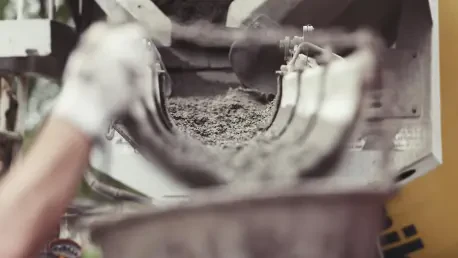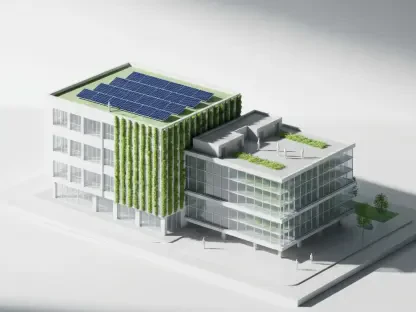As the world grapples with the escalating threat of climate change, the cement industry stands out as one of the most pressing challenges. Responsible for around 8% of global CO₂ emissions, cement production is a major contributor to the carbon footprint of the construction sector. Against this backdrop, RockFuel, a UK-based company, has introduced a groundbreaking approach to cement production that could revolutionize the industry. This innovative process not only targets emission reduction but aims to reverse emissions, presenting the possibility of a truly carbon-negative cement production cycle.
Shifting Paradigms: RockFuel’s Closed-Loop Manufacturing System
Carbon Neutral Lime Kiln Technology
At the heart of RockFuel’s pioneering efforts is its patented closed-loop manufacturing system, which incorporates a Carbon Neutral Lime Kiln capable of producing quicklime (CaO) while capturing CO₂ emissions in the process. Traditional cement kilns have been notorious for releasing huge quantities of CO₂ directly into the atmosphere. By contrast, RockFuel’s kiln operates using renewable energy sources, allowing the company to capture an impressive 500 cubic meters of CO₂ for each cubic meter of limestone rock processed. The captured CO₂ is then stored in dedicated tanks for future utilization, marking a significant departure from conventional methods that typically focus on sequestration or storage.
This innovative system not only captures carbon emissions at the manufacturing stage but also reintegrates the CO₂ into the production cycle. By effectively returning CO₂ into the cement production process, RockFuel’s technology transforms cement into a carbon sink. This means that as the cement cures in construction applications, it absorbs more atmospheric CO₂, thus achieving a carbon-negative status throughout its lifecycle. This breakthrough positions RockFuel as a front-runner in the move towards sustainable construction and global decarbonization initiatives.
Multiple Outputs and Industrial Byproducts
RockFuel’s strategy capitalizes on using excess energy from its closed-loop system to drive electrolysis, turning captured CO₂ into solid carbon and carbon-neutral oxygen. The solid carbon produced can be applied to advanced material industries, including carbon fiber and graphene production. Simultaneously, the oxygen generated has numerous industrial applications, spanning sectors such as steel manufacturing, wastewater treatment, medical technology, and chemistry. This multi-output system not only minimizes waste but also creates new revenue opportunities, enhancing its appeal to investors and solidifying its position as an attractive manufacturing partner.
In a world where economies are increasingly driven by sustainable practices, RockFuel’s approach aligns seamlessly with market demands for eco-friendly solutions. With industries actively seeking materials that demonstrate verifiable carbon reductions, RockFuel’s technology is both relevant and necessary. The ability to generate valuable byproducts further bolsters its market position, while contributing to broader sustainability goals on an industrial scale.
The Rising Demand for Sustainable Cement Solutions
Growing Market and Regulatory Pressures
The cement industry’s growth trajectory is projected to continue, with market value expected to climb considerably over the next few years. However, this growth is paralleled by increasing scrutiny and stricter carbon regulations, particularly in regions such as North America and Europe. While the Asia-Pacific region leads in terms of volume production, the need for sustainable innovation has primarily been driven by regulatory pressures from Western regions. As a result, stakeholders, including governments, investors, and developers, are on the lookout for materials that not only mitigate emissions but also offer performance and cost-effectiveness.
In response to these demands, RockFuel’s technology stands ready as a viable solution. By maintaining the chemical properties of traditional cement, it acts as a drop-in substitute for existing construction applications. This compatibility is integral for infrastructure projects, including transportation networks, commercial buildings, and renewable energy installations, to comply with evolving environmental standards. Cement’s historical role in construction is thus maintained while ensuring progress towards environmental sustainability.
Validation and Global Partnerships
RockFuel’s technology has undergone rigorous validation and assessment, securing multiple international patents in preparation for licensing and worldwide industrial adoption. Independent evaluations have affirmed both the chemical engineering soundness and the commercial potential of their approach. This solid foundation paves the way for RockFuel to pursue strategic partnerships with a host of stakeholders.
The company is actively seeking collaboration with cement, lime, and concrete producers, universities and research institutions with a focus on sustainability innovations, as well as government agencies prioritizing green infrastructure. Additionally, partnerships with impact investors and clean-tech funds are in the works, aiming to tap into a global audience in pursuit of scalable climate solutions. These alliances reinforce RockFuel’s positioning in the market, advancing its mission to become a cornerstone of sustainable construction.
Rethinking Cement for a Sustainable Future
Active Role in Climate Change Mitigation
The overarching theme in the move towards carbon-negative cement reflects an urgent need for industries historically marked by high emissions to pivot towards sustainability. RockFuel’s technology not only demonstrates the possibility of transforming CO₂ emissions into valuable outputs but also reinvigorates the role of cement-based infrastructures as active participants in atmospheric carbon reduction. It showcases the potential for cement production to become a leader in climate change mitigation efforts, turning the sector from an emissions liability to an environmental asset.
As global environmental targets become increasingly ambitious, the construction industry faces growing pressure to adopt greener practices. RockFuel’s innovation provides a glimpse of how this can be accomplished, presenting a model where technological advancement, circular design, and energy transition goals align harmoniously. By illustrating the possibility of a carbon-negative cement production, RockFuel offers a template for sustainable industrial transformation.
Future Directions and Opportunities
As the global community confronts the increasingly urgent threat posed by climate change, the cement industry emerges as a significant concern due to its environmental impact. Currently, cement production is responsible for approximately 8% of worldwide CO₂ emissions, marking it as a considerable factor in the overall carbon footprint associated with construction. Within this context, RockFuel, a forward-thinking company based in the United Kingdom, has unveiled a groundbreaking methodology that could potentially transform cement manufacturing. This pioneering process not only focuses on mitigating emissions but also strives to reverse them, offering the remarkable potential for establishing a genuinely carbon-negative cycle in cement production. The implications of RockFuel’s approach could be profound, potentially setting new standards in ecological practices within the industry and paving the way for other sectors to adopt similar strategies in the fight against climate change.









